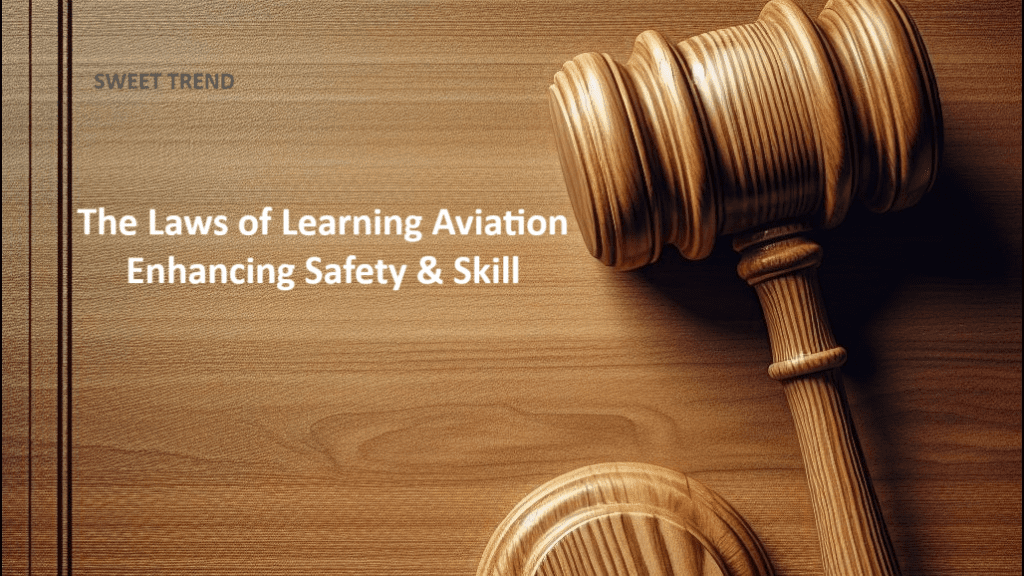In the high-stakes world of aviation, where split-second decisions can mean the difference between life and death, there is one unwavering truth: continuous learning is not just a necessary component; it is an essential lifeline. Pilots must constantly hone their skills, broaden their knowledge, and stay abreast of industry advancements to ensure safety in the skies. But what if there were specific laws or principles that could guide pilots in their pursuit of effective learning? What if these principles have the power to sharpen skills and enhance overall performance? In this article of Laws of Learning Aviation, we will explore the fundamental laws of learning in aviation that can revolutionize pilot training programs and elevate safety standards.
The first law we delve into is known as the Primacy-Recency Effect. Research has long shown that information presented at the beginning (primacy) and end (recency) of a training session tends to be better retained by learners. This effect has significant implications for structuring training sessions for pilots. By capitalizing on this principle, trainers can strategically introduce critical concepts early on to capture maximum attention and reinforce key learnings towards the end for optimal retention. To further enhance the impact of this effect during trainings, various techniques such as priming exercises before important modules or recapitulating key takeaways after each session should be employed.
By unlocking the potential of understanding how our brains retain information based on its timing within a training program, pilots will have a distinct advantage when it comes to consolidating vital knowledge needed during mission-critical situations. Join us as we dive deeper into strategies inspired by this profound yet practical concept alongside other laws governing effective learning in aviation. Gain insights from experts who have harnessed these very principles to shape unparalleled pilot’s education methodologies aimed at enhancing safety measures while elevating skill levels exponentially throughout their careers
Active Learning Through Simulations
Flight simulations have revolutionized aviation training by providing a highly immersive and interactive learning experience. These simulators allow pilots to actively engage with realistic scenarios, replicating the challenges they may face in actual flights. By putting theory into practice, pilots can accelerate their skill development in a safe and controlled environment.

There are various types of flight simulators available that cater to different training needs. Full-motion simulators offer a complete sensory experience, recreating the feeling of being inside an aircraft cockpit. They simulate complex maneuvers, weather conditions, and emergency situations with astonishing accuracy. Fixed-base simulators provide a more cost-effective option without compromising on realism, focusing primarily on instrument training and system familiarization.
The Power of Repetition
In aviation, repetitive practice is not just encouraged – it is essential for retaining knowledge and building muscle memory. Pilots must perform certain procedures instinctively under high-stress situations without having to think twice about them. By regularly repeating these actions during training sessions, pilots reinforce pathways in their brain that strengthen recall abilities when facing real-world challenges.
To incorporate repetition into training routines effectively requires deliberate planning and organization. Flight instructors often structure lessons around specific tasks or maneuvers repetitively until mastery is achieved before moving on to new skills. This iterative approach allows pilots to build confidence gradually while consolidating their understanding of fundamental concepts.
Transferability Within Aviation Domains
One remarkable aspect of aviation skill development is the transferability across different aircraft types or situations within the field itself. For example, mastering flying techniques in one domain like fixed-wing aircraft can lay a solid foundation for success if transitioning later into rotary-wing operations or vice versa.
Cross-training opportunities exist within various areas such as navigation systems, communication protocols, emergency procedures, decision-making strategies – all domains where principles remain consistent regardless of the specific equipment used or operating environment faced.
Feedback Loops: A Blueprint for Improvement
Feedback is a critical aspect of the learning process, enabling pilots to identify areas in need of improvement and make necessary adjustments. In aviation training, feedback comes from multiple sources such as flight instructors, peers, self-analysis through debriefings or video footage, and even computerized assessment systems.
Effective feedback mechanisms provide specific insights into performance strengths and weaknesses. They offer guidance on refining techniques or procedures that may require further attention. By leveraging these feedback loops correctly, pilots can systematically enhance their skills over time.
Applying Mnemonics Techniques
In the dynamic world of aviation where quick decision-making is vital, mnemonic devices play an integral role as memory aids for pilots. These techniques help them retain vast amounts of information by associating it with easily memorable cues or patterns.
Commonly used mnemonics in aviation training include acronyms like ARROW, which stands for Aircraft Documents Required Onboard (Airworthiness Certificate, Registration Certificate, Operating Limitations/Pilot’s Operating Handbook). Other mnemonic approaches involve visualization techniques to remember complex cockpit checklists or procedure flows effectively.
By incorporating mnemonic strategies into their training routines, pilots benefit from improved recall during critical moments when split-second decisions are necessary for safety and operational effectiveness.
The Importance of Learning from Mistakes
In the aviation industry, learning from mistakes is not just a valuable skill; it’s an essential one. Every pilot encounters challenges and makes errors at some point in their career. However, what sets apart exceptional pilots from average ones is their ability to analyze these mistakes, learn from them, and prevent similar mishaps in the future.
One strategy for creating a culture of continuous improvement is fostering an open environment where pilots feel comfortable reporting and discussing errors without fear of punitive measures. This can be achieved by implementing a non-punitive reporting system that allows pilots to report near-misses or errors confidentially. By doing so, the focus shifts from blaming individuals to identifying systemic issues that could have led to the mistake.
Furthermore, regular debriefing sessions after flights play a crucial role in learning from mistakes. These sessions provide an opportunity for pilots to openly discuss their experiences and share any lessons learned with their colleagues. By encouraging open discussion about mistakes made during flights, opportunities arise for collective learning and preventing similar accidents or incidents in the future.
Remember, success in aviation isn’t based solely on how many hours you’ve logged or how technically proficient you are; it also hinges on your ability to recognize and learn from your mistakes. By emphasizing the importance of analyzing errors promptly and taking proactive steps towards improvement both individually and as a community, we can enhance safety levels across the entire industry while continuously improving our skills as aviators.
Conclusion (Laws of Learning Aviation)
In this article, we have explored the fundamental laws of learning aviation and their significance in enhancing safety and skill for pilots. We began by delving into the importance of the law of practice, which emphasizes repetitive and intentional practice as a means to develop muscle memory and improve performance. We also examined the law of primacy, highlighting the crucial role that initial learning plays in shaping long-term behavior.
Furthermore, we discussed the law of readiness, emphasizing that learners must be mentally prepared and motivated to acquire new knowledge or skills effectively. By understanding this principle, aviators can ensure they are in an optimal state to learn and retain critical information during training sessions or simulation exercises.
The next principle we explored was the law of exercise frequency. This concept highlights that regular training is essential for maintaining proficiency levels as well as adapting to changes within aviation technology or regulations. By consistently practicing flying techniques or studying updated flight manuals, pilots can stay abreast with industry best practices and contribute towards their own continuous improvement.
Lastly, we covered the important concept known as transferable learning. This principle encapsulates how experience gained from one aspect of aviation can be applied to other areas within flight operations. Developing a diverse skill set through cross-training not only supports professional growth but also fosters adaptability in handling different aircraft types or flying conditions.
Throughout this article, it has become evident that continual learning is vital for safe and skilled aviators alike. The laws of learning aviation provide a framework for developing expertise while reinforcing established procedures aimed at promoting safety within an ever-evolving industry.
By embracing these principles as integral components of their training regime, pilots can enhance their technical proficiency while minimizing risks associated with human error – ensuring safer skies for all who take part in air travel.



